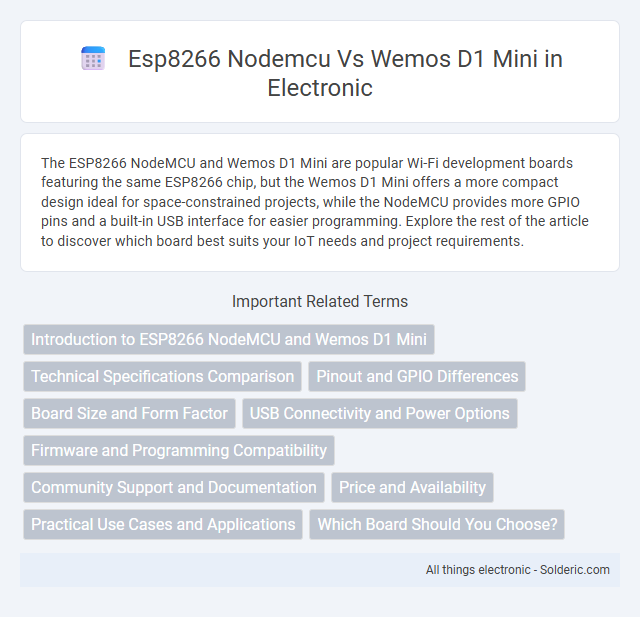The ESP8266 NodeMCU and Wemos D1 Mini are popular Wi-Fi development boards featuring the same ESP8266 chip, but the Wemos D1 Mini offers a more compact design ideal for space-constrained projects, while the NodeMCU provides more GPIO pins and a built-in USB interface for easier programming. Explore the rest of the article to discover which board best suits your IoT needs and project requirements.
Comparison Table
| Feature | ESP8266 NodeMCU | Wemos D1 Mini |
|---|---|---|
| WiFi Chip | ESP8266 | ESP8266 |
| Microcontroller | ESP8266EX | ESP8266EX |
| Operating Voltage | 3.3V | 3.3V |
| USB Interface | Micro USB | Micro USB |
| GPIO Pins | ~17 (varies with model) | 11 |
| Flash Memory | 4MB (typical) | 4MB (typical) |
| Dimensions | 48mm x 26.6mm | 34.2mm x 25.6mm |
| Power Consumption | ~70mA (active WiFi) | ~70mA (active WiFi) |
| Price | Typically lower | Typically slightly higher |
| Use Case | Prototyping, IoT projects needing more pins | Compact IoT, space-constrained projects |
Introduction to ESP8266 NodeMCU and Wemos D1 Mini
ESP8266 NodeMCU and Wemos D1 Mini are popular development boards powered by the ESP8266 Wi-Fi microcontroller, widely used for IoT projects. NodeMCU features a larger form factor with built-in USB support, making it ideal for beginners and prototyping, while Wemos D1 Mini offers a compact design suitable for space-constrained applications. Your choice depends on project size constraints and ease of programming, with both boards supporting Arduino IDE for seamless coding.
Technical Specifications Comparison
The ESP8266 NodeMCU and Wemos D1 Mini both feature the ESP8266 microcontroller with 80 MHz CPU speed and 4 MB flash memory, but the NodeMCU offers more GPIO pins (usually 17) compared to the Wemos D1 Mini's 11, impacting your project's I/O capabilities. Both boards support Wi-Fi 802.11 b/g/n, ADC, and UART interfaces, yet the NodeMCU's larger form factor accommodates USB-to-serial converters and more power options, while the Wemos D1 Mini prioritizes compact design with a micro USB port and integrated voltage regulator. Your choice hinges on balancing pin availability and board size with power consumption and peripheral requirements.
Pinout and GPIO Differences
The ESP8266 NodeMCU features 30 pins with a flexible layout supporting various functions, whereas the Wemos D1 Mini provides 11 digital I/O pins optimized for compact design. NodeMCU includes additional ADC pins and more GPIOs like GPIO16 for deep sleep wakeup, while Wemos D1 Mini has fewer GPIOs but includes integrated USB and voltage regulator for easier programming. Pin labeling differs, with NodeMCU exposing pins in castellated form and Wemos D1 Mini using a more compact shield form factor suitable for breadboard compatibility.
Board Size and Form Factor
The ESP8266 NodeMCU features a larger development board with built-in USB-to-serial adapter, measuring approximately 48mm x 26mm, offering more GPIO pins and easier prototyping. In contrast, the WeMos D1 Mini measures a compact 34.2mm x 25.6mm, ideal for space-constrained projects while maintaining essential ESP8266 capabilities. The smaller form factor of the WeMos D1 Mini lends itself to breadboard compatibility and integration in tight enclosures without sacrificing WiFi performance.
USB Connectivity and Power Options
The ESP8266 NodeMCU features a built-in micro USB port for easy programming and power supply, supporting 5V input via the USB connector and onboard voltage regulation to 3.3V. In contrast, the Wemos D1 Mini offers a smaller form factor with a micro USB port primarily for power and programming, relying on an external 5V supply regulated down to 3.3V onboard. Both modules provide USB connectivity for seamless development, but the NodeMCU's larger board accommodates more robust power regulation components compared to the compact Wemos D1 Mini.
Firmware and Programming Compatibility
ESP8266 NodeMCU and Wemos D1 Mini both support the Arduino IDE and Lua firmware, offering seamless programming flexibility for IoT projects. Firmware compatibility ensures you can upload custom code or leverage existing libraries without significant adjustments between the two boards. Your choice depends on form factor preferences, but development environments and firmware flashing processes remain largely consistent.
Community Support and Documentation
The ESP8266 NodeMCU and WeMos D1 Mini both enjoy strong community support, but NodeMCU offers more extensive documentation and a larger user base due to its longer presence in the market. You will find numerous tutorials, forums, and GitHub repositories dedicated to NodeMCU, making troubleshooting and development faster. WeMos D1 Mini also has solid resources, but its smaller form factor means specialized use cases might require additional research.
Price and Availability
The ESP8266 NodeMCU and Wemos D1 Mini are both affordable development boards widely available in online electronics stores and marketplaces. The Wemos D1 Mini typically has a lower price point due to its compact size and minimalist design, making it ideal for budget-conscious projects or those requiring small form factors. Your choice may depend on availability in your region and the balance between cost and functionality needed for your IoT applications.
Practical Use Cases and Applications
ESP8266 NodeMCU is ideal for IoT projects requiring easy programming and USB connectivity, such as smart home automation and sensor data collection, due to its built-in CP2102 USB-to-serial converter. Wemos D1 Mini excels in compact applications like wearable devices and small-scale environmental monitoring because of its smaller footprint and compatibility with Arduino IDE. Both support Wi-Fi connectivity, making them suitable for remote control and real-time data transmission in wireless network environments.
Which Board Should You Choose?
Choose the ESP8266 NodeMCU board if you need more GPIO pins and an integrated USB interface for easy programming and debugging. Opt for the Wemos D1 Mini when working on compact projects requiring a smaller footprint without sacrificing Wi-Fi connectivity and basic GPIO capabilities. Consider your project's size constraints, pin requirements, and ease of development to select the best board.
esp8266 nodemcu vs wemos d1 mini Infographic

 solderic.com
solderic.com